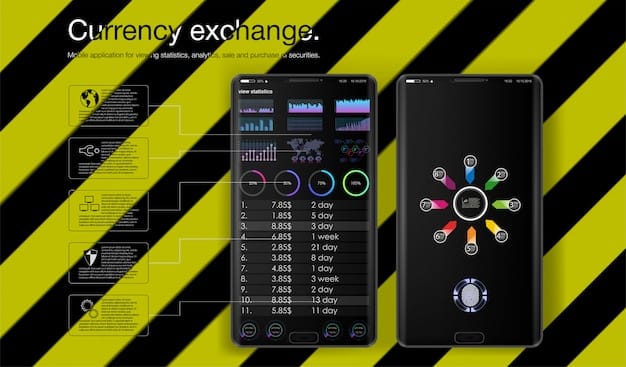Mobile Threat Detection: Protecting US Employees & Data

Mobile Threat Detection (MTD) is crucial for safeguarding US employees and company data from mobile malware and phishing attacks by providing real-time threat identification, proactive security measures, and ensuring compliance with data protection regulations.
In today’s digital landscape, mobile devices are integral to business operations, but they also present significant security risks. Mobile Threat Detection: Protecting Your US Employees and Data from Mobile Malware and Phishing Attacks is essential for maintaining a secure environment for your business and employees.
Understanding the Mobile Threat Landscape in the US
The threat landscape for mobile devices is constantly evolving, with cybercriminals developing increasingly sophisticated methods to target smartphones and tablets. For businesses in the US, understanding these threats is the first step in implementing effective protection.
Common Types of Mobile Threats
Mobile devices are vulnerable to various threats, including malware, phishing attacks, and network-based attacks. Each type of threat requires different protection strategies.
- Malware: Malicious software designed to infiltrate and damage mobile devices, often disguised as legitimate apps.
- Phishing Attacks: Deceptive attempts to steal sensitive information, such as login credentials or financial data, through fraudulent emails, SMS messages, or websites.
- Network-Based Attacks: Exploiting vulnerabilities in mobile networks to intercept data or gain unauthorized access to devices.
The Increasing Sophistication of Threats
Cybercriminals are becoming more adept at bypassing traditional security measures. They use advanced techniques to create malware that is difficult to detect and launch phishing campaigns that are highly convincing.
Staying ahead of these threats requires a proactive approach to security, including implementing robust mobile threat detection solutions and educating employees about potential risks.

In conclusion, understanding the nature and sophistication of mobile threats is crucial for businesses in the US. By recognizing the risks and implementing appropriate security measures, organizations can protect their employees and data from these ever-evolving threats.
The Importance of Mobile Threat Detection (MTD)
Mobile Threat Detection (MTD) solutions play a critical role in safeguarding mobile devices and data from an array of cyber threats. Businesses in the US can greatly benefit from implementing these solutions to enhance their overall security posture.
Real-Time Threat Identification
MTD solutions provide real-time scanning and analysis of mobile devices to identify and respond to threats as they emerge. This proactive approach helps prevent malware infections and data breaches before they can cause significant damage.
Real-time threat identification enables businesses to quickly mitigate risks and minimize potential disruptions to operations.
Proactive Security Measures
These solutions do not just react to threats; they also proactively identify vulnerabilities and recommend actions to strengthen security. This includes monitoring app behavior, detecting suspicious network activity, and enforcing security policies.
MTD solutions empower businesses to proactively manage mobile security risks and prevent future attacks.
Implementing a comprehensive MTD strategy is essential for businesses looking to protect their mobile devices and data. Let’s delve into some key points:
- Continuous Monitoring: MTD solutions continuously monitor devices for signs of compromise, ensuring ongoing protection.
- Behavioral Analysis: By analyzing app and user behavior, MTD can detect anomalies that may indicate a threat.
- Automated Response: MTD solutions can automatically respond to threats, such as isolating infected devices or blocking malicious apps.
MTD solutions are an essential component of a comprehensive security strategy, providing real-time threat identification and proactive security measures to protect mobile data.
Key Features of Effective MTD Solutions
Effective mobile threat detection solutions offer a range of features designed to identify and mitigate mobile threats. Understanding these features can help businesses choose the right solution for their needs.
App Scanning and Analysis
MTD solutions scan installed apps for malicious code and analyze their behavior to identify potential threats. This includes checking for permissions that apps request and how they access sensitive data.
Network Threat Protection
MTD solutions monitor network traffic for suspicious activity, such as connections to known malicious websites or attempts to intercept data. This helps protect against phishing attacks and other network-based threats.
When evaluating MTD solutions, consider the following key features:
- Vulnerability Assessments: Identifying weaknesses in device configurations and recommending security improvements.
- Anti-Phishing: Protecting against phishing attacks by blocking malicious websites and alerting users to suspicious emails and SMS messages.
- Data Loss Prevention (DLP): Preventing sensitive data from being leaked or stolen from mobile devices.

Effective MTD solutions provide comprehensive protection against mobile threats by scanning apps, monitoring network traffic, and offering features like vulnerability assessments and anti-phishing protection.
Implementing MTD in Your Organization
Implementing a mobile threat detection solution requires careful planning. It’s a crucial step to ensure that it aligns with your organization’s security objectives and provides effective protection for your mobile devices. Here’s how:
Assessing Your Organization’s Needs
Start by evaluating the specific mobile security needs of your organization. Consider the types of devices used, the sensitivity of the data accessed, and the potential threats faced.
Choosing the Right MTD Solution
Select an MTD solution that meets your organization’s needs and aligns with your budget. Consider factors such as the number of devices to be protected, the features offered, and the level of support provided.
To properly implement MTD and maximize its effectiveness, consider the additional pointers below:
- Develop a comprehensive mobile security policy that outlines acceptable use guidelines, security requirements, and incident response procedures.
- Educate employees about mobile security threats and best practices for protecting their devices and data.
- Continuously monitor and update your MTD solution to ensure it remains effective against emerging threats.
Implementing MTD in your organization involves assessing your needs, choosing the right solution, developing security policies, educating employees, and continuously monitoring and updating the solution.
The Role of Employee Training in Mobile Security
While mobile threat detection (MTD) solutions are critical for protecting mobile devices, they are only one part of a comprehensive security strategy. Employee training plays a crucial role in enhancing mobile security and reducing the risk of human error.
Recognizing Phishing Attempts
Employees should be trained to recognize phishing attempts and avoid clicking on suspicious links or providing sensitive information. This includes educating them about the common tactics used by cybercriminals, such as deceptive emails and SMS messages.
Best Practices for Mobile Device Usage
Training should also cover best practices for mobile device usage, such as using strong passwords, enabling multi-factor authentication, and keeping software up to date. Emphasize the importance of only downloading apps from trusted sources.
Employee awareness and training are crucial components of a complete mobile security program. To further help ensure your employees are fully protected, consider the advice below:
- Simulated Phishing Attacks: Conduct regular simulated phishing attacks to test employees’ awareness and identify areas for improvement.
- Regular Training Sessions: Provide regular training sessions to keep employees up to date on the latest threats and security best practices.
- Security Awareness Campaigns: Launch security awareness campaigns to promote a culture of security within the organization.
Employee training is essential for enhancing mobile security, and it involves educating employees about phishing attempts, best practices for mobile device usage, and promoting a culture of security.
Compliance and Regulatory Considerations for US Businesses
US businesses must adhere to various compliance and regulatory requirements related to data protection and privacy. Mobile threat detection can help businesses meet these requirements and avoid costly penalties.
HIPAA Compliance
The Health Insurance Portability and Accountability Act (HIPAA) requires healthcare organizations to protect sensitive patient information. MTD solutions can help ensure that mobile devices used to access or store patient data are secure and compliant with HIPAA regulations.
CCPA Compliance
The California Consumer Privacy Act (CCPA) grants California residents certain rights related to their personal information. Businesses subject to the CCPA must implement appropriate security measures to protect consumer data, including data stored on mobile devices. MTD can play a role in meeting these requirements.
Meeting these compliance regulations can seem challenging, but with the right information and tools, it’s fully achievable. Here are some key factors to consider:
- Data Encryption: Encrypt sensitive data stored on mobile devices to protect it from unauthorized access.
- Access Controls: Implement strict access controls to limit who can access sensitive data on mobile devices.
- Regular Audits: Conduct regular security audits to identify and address any vulnerabilities or compliance gaps.
Compliance and regulatory considerations are important for US businesses, and MTD can help meet requirements such as HIPAA and CCPA by providing data encryption, access controls, and regular security audits.
| Key Point | Brief Description |
|---|---|
| 🛡️ Real-Time Threat Detection | Immediate identification and response to emerging mobile threats. |
| 🚨 Employee Training | Educating staff to recognize and avoid phishing & other scams is crucial. |
| 🔒 Compliance | Ensuring adherence to regulations like HIPAA and CCPA for data protection. |
| 📱 Mobile Security Policy | Developing written policies outlining necessary security procedures. |
FAQ
▼
Mobile Threat Detection (MTD) refers to the solutions and practices developed to identify, prevent, and mitigate security risks targeting mobile devices. The main goal of MTD solutions is to protect sensitive business and personal data from malware, phishing, and network-based attacks.
▼
MTD is critical for US businesses due to the increasing reliance on mobile devices for daily operations, which unfortunately expands the business’s attack surface. Protecting company and customer data is required to maintain operational continuity, compliance with regulations, and customer trust.
▼
Employee training is vital because humans are often the weakest link in security. Training helps employees recognize phishing attempts, adhere to security policies, and adopt best practices such as using strong passwords, which greatly reduces the chance of security breaches.
▼
Key features of effective MTD solutions include real-time scanning for malicious apps, network threat protection, vulnerability assessments, and data loss prevention. These features act together to make a comprehensive security solution for mobile devices.
▼
MTD assists with regulatory compliance by providing the tools needed to secure sensitive data on mobile devices in accordance with laws such as HIPAA and CCPA. Features like data encryption, access controls, and regular audits ensure you comply with strict standards.
Conclusion
In conclusion, Mobile Threat Detection: Protecting Your US Employees and Data from Mobile Malware and Phishing Attacks involves a multifaceted approach that combines technology, policy, and employee education. Implementing MTD solutions, providing comprehensive training, and staying informed about the evolving threat landscape are essential steps for safeguarding your organization from the risks associated with mobile devices.





